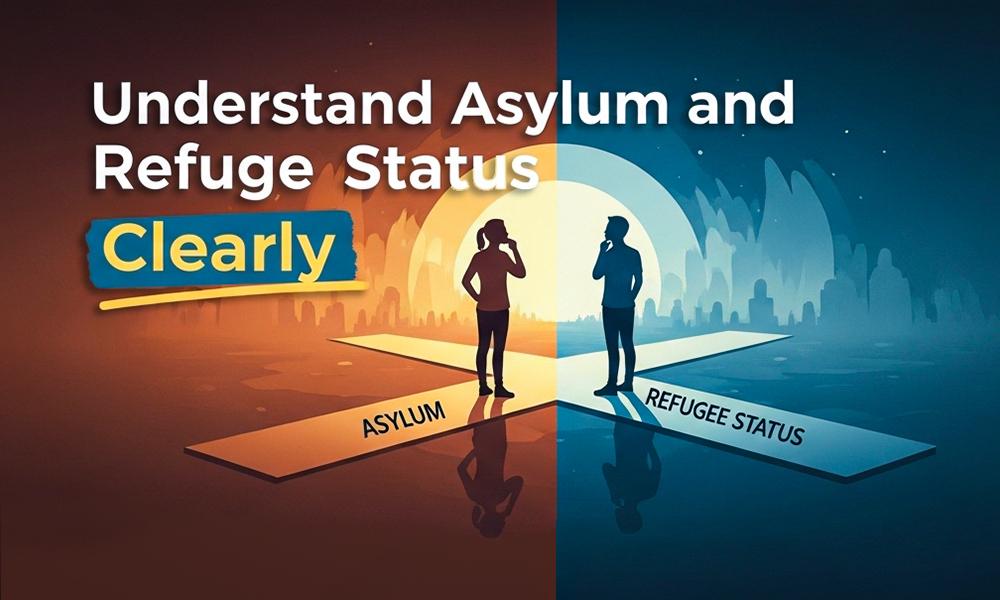The terms asylum and refugee are closely related but have distinct legal meanings. Understanding the asylum vs refugee difference is essential for anyone seeking protection or navigating humanitarian immigration processes. While both involve fleeing persecution, the main distinction lies in where the person applies for protection (USCIS).
Statutory Definition Under U.S. Law
Refugee Definition (Outside the U.S.)
According to INA §101(a)(42): > “Any person who is outside any country of such person’s nationality… and who is unable or unwilling to return to that country because of persecution or a well-founded fear of persecution on account of race, religion, nationality, membership in a particular social group, or political opinion” (U.S. Code).
This applies to individuals seeking refugee status before entering the U.S., typically through the U.S. Refugee Admissions Program (USRAP).
Asylee Definition (Inside the U.S.)
in the U.S. or at a port of entry is eligible to seek asylum (U.S. Code).
Refugee: Applies from outside the U.S.
Asylee: Applies inside the U.S. or at a port of entry
Both are protected under the same law but differ in application location and processing procedure (USCIS).
Key Differences Between Asylum and Refugee Status
Basis | Asylum (Asylee) | Refugee |
Location of Application | Inside the U.S. or at border | Outside the U.S., via UNHCR or embassy |
Application Process | File Form I-589 | Apply through USRAP |
Screening Agency | USCIS Asylum Office / Immigration Court | U.S. State Department & UNHCR |
Entry Status | Already present | Approved before entry |
Rights After Approval | Work, family reunification, Green Card after 1 year | Same rights; Green Card after 1 year |
Asylum is requested after arrival, while refugee status is granted before entry (Migration Policy Institute).
Who Qualifies as a Refugee?
Refugees must: – Be outside their home country – Have a well-founded fear of persecution due to race, religion, nationality, political opinion, or social group – Be referred by UNHCR, a U.S. embassy, or an authorized organization (UNHCR)
Who Can Seek Asylum?
Asylum seekers are already in the U.S. or at a port of entry and fear persecution.
Two main types: 1. Affirmative Asylum – Applied directly to USCIS 2. Defensive Asylum – Filed during removal proceedings
Applicants generally file Form I-589 within one year of arrival unless exceptions apply (USCIS).
Rights of Refugees vs Asylum Seekers
Once approved, both groups: – Can live and work legally in the U.S. – Can apply for a Green Card after one year – Can petition for certain family members
Pending asylum seekers may have limited access to work authorization or benefits (USCIS).
International Laws Governing Refugees and Asylum
The 1951 Refugee Convention and 1967 Protocol establish global protection standards. Under Article 14 of the Universal Declaration of Human Rights, everyone has the “right to seek and enjoy asylum from persecution” (UNHCR).
Organizations like UNHCR and IOM manage refugee resettlement and support asylum seekers (Amnesty International).
Common Misconceptions
Myth: Asylum seekers enter illegally. Fact: Applying for asylum is a legal right under U.S. and international law (Amnesty International)
Myth: Refugees take jobs from citizens. Fact: Refugees contribute positively to the economy (Migration Policy Institute)
Challenges Faced by Asylum Seekers and Refugees
Lengthy processing times due to backlogs
Complex legal procedures
Cultural and language adaptation difficulties
Psychological trauma from persecution (American Immigration Council)
Global Statistics and Humanitarian Impact
According to UNHCR 2024, over 43 million refugees and 6 million asylum seekers are displaced globally, including crises in Syria, Afghanistan, and Ukraine (UNHCR).
Can Someone Be Both a Refugee and an Asylum Seeker?
Yes. Every refugee begins as an asylum seeker, though not all asylum seekers are eventually recognized as refugees (USCIS).
FAQs
Q1: Can someone be both a refugee and an asylum seeker? A: Legally, a person holds one status at a time, but many refugees start as asylum seekers.
Q2: Where do refugees and asylum seekers apply? A: Refugees apply from outside via UNHCR or resettlement programs; asylum seekers apply inside the U.S.
Q3: Is asylum a right? A: Yes, under international law and U.S. law, anyone can request asylum.
Q4: How long does it take to get asylum in the U.S.? A: Processing can take months to years depending on backlog (American Immigration Council).
Q5: What happens if an asylum claim is denied? A: Applicants may appeal to the Board of Immigration Appeals or seek other protections (USCIS).

